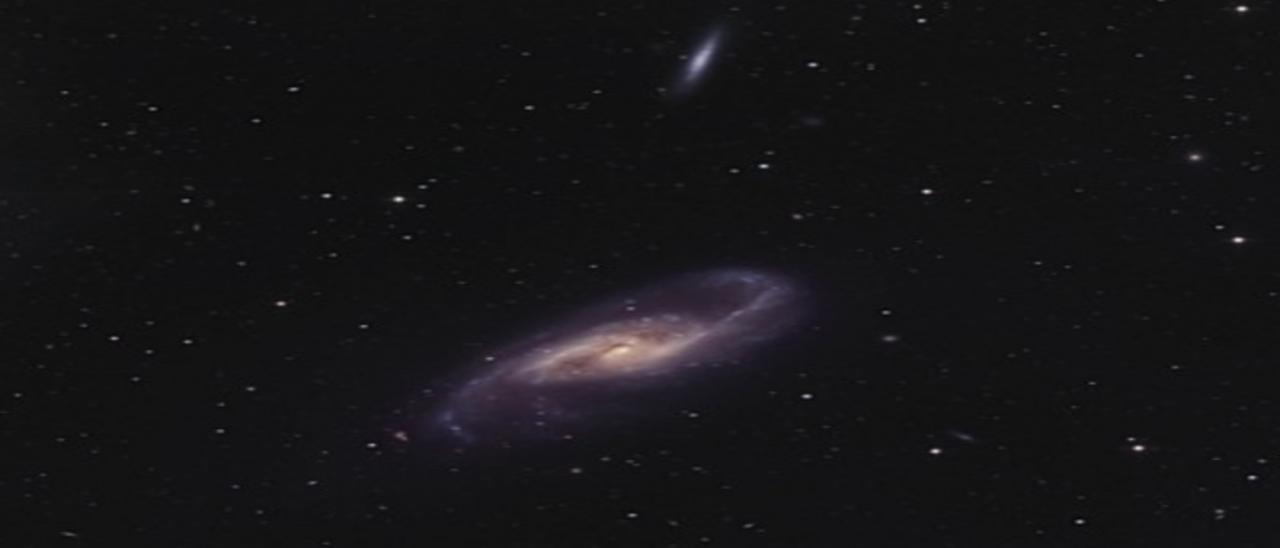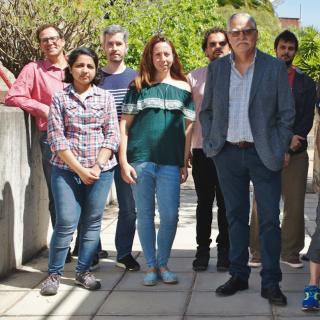Grants related:
General
Our small group is well known and respected internationally for our innovative and important work on various aspects of the structure and evolution of nearby spiral galaxies. We primarily use observations at various wavelengths, exploiting synergies that allow us to answer the most pertinent questions relating to what the main properties of galaxies are, and how galaxies have evolved to their current state. We use imaging and spectroscopy, at UV, optical, infrared, millimetre, and radio wavelengths, fully exploiting observing facilities available to us in Spain, at ESO, or elsewhere, along with state-of-the-art analysis tools. The success of this approach can be measured from the employment opportunities offered to ex-members of the group, from the number and quality of collaborations with leading external scientists, from continued citation of our published work, and from invitations to co-organise or speak at the leading international conferences in the field.
In the last few years our group has put a lot of effort into opening up joint research lines with computer scientists, recognising the paradigm shift that is upon us due to the enormous quantities of data that will soon be produced by facilities such as LSST, Euclid, and SKA. We collaborate with computer scientists and aim to prepare the analysis tools, including detection of structure from noise, correction for scattered light and Galactic cirrus, and the use of machine learning-based techniques, so that once LSST (2020) and Euclid (2023) start releasing their huge data sets, our group is ready to analyse them and extract the science from the oceans of bytes.
Members
Results
- From thermal and non-thermal radio maps of the centre of NGC 1097, we discovered that the massive star formation is quenched by non-thermal effects, including pressure from the magnetic field, cosmic rays and turbulence.
- In the centre of NGC 7742, we found a slightly warped inner disk, and two separate stellar components: an old population that counter-rotates with the gas, and a young one, concentrated to the ring, that co-rotates with the gas.
- We re-analysed our deep IR imaging of thick disks to correct for the extended S4G point spread function (PSF), confirming all our previous results and in particular confirming the significant mass present in the thick disk component.
- Analysing a new high-resolution e-MERLIN 1.5 GHz radio continuum map together with HST and SDSS imaging of NGC 5322, an elliptical galaxy hosting radio jets, we found that the low-luminosity AGN/jet-driven feedback may have quenched the late-time nuclear star formation promptly.
- From MUSE observations of low-surface-brightness Lyman-α emission surrounding faint galaxies at redshifts between 3 and 6 we find that the projected sky coverage approaches 100 per cent.
Scientific activity
Related publications
-
SDSS-IV MaNGA: stellar population gradients within barred galaxies
Bars in galaxies are thought to stimulate both inflow of material and radial mixing along them. Observational evidence for this mixing has been inconclusive so far, however, limiting the evaluation of the impact of bars on galaxy evolution. We now use results from the MaNGA integral field spectroscopic survey to characterize radial stellar age and
Fraser-McKelvie, Amelia et al.Advertised on:
92019 -
Inner and outer rings are not strongly coupled with stellar bars
Rings are distinctive features of many disc galaxies and their location and properties are closely related to the disc dynamics. In particular, rings are often associated to stellar bars, but the details of this connection are far from clear. We have studied the frequency and dimensions of inner and outer rings in the local Universe as a function
Díaz-García, S. et al.Advertised on:
52019 -
Unveiling the 100 pc scale nuclear radio structure of NGC 6217 with e-MERLIN and the VLA
We present high-sensitivity 1.51 GHz e-MERLIN (e-Multi-Element Radio-Linked Interferometer Network) radio images of the nearby galaxy NGC 6217. We resolve the compact radio source at the centre of NGC 6217 for the first time, finding a twin-lobed structure with a total linear size of ˜4 arcsec (˜400 pc). The radio source does not have a compact
Williams, D. R. A. et al.Advertised on:
72019 -
The new 4-m robotic telescope
We present a project to build a 4-m-diameter telescope (New Robotic Telescope [NRT]) with fully robotic operation. The telescope will be sited at the Observatory of Roque de los Muchachos in the island of La Palma (Spain). When it enters into operation in 5 years' time, it will be likely the largest robotic telescope in the world. This, in
Gutiérrez, C. M. et al.Advertised on:
12019 -
Star formation and gas in the minor merger UGC 10214
Minor mergers play a crucial role in galaxy evolution. UGC 10214 (the Tadpole galaxy) is a prime example of this process in which a dwarf galaxy has interacted with a large spiral galaxy ˜250 Myr ago and produced a perturbed disc and a giant tidal tail. We used a multi-wavelength dataset that partly consists of new observations (Hα, HI, and CO) and
Rosado-Belza, D. et al.Advertised on:
32019 -
The kinematics of local thick discs do not support an accretion origin⋆
Thick discs are nearly ubiquitous components of the discs of present-day galaxies. It has been proposed that a fraction of their stars have been accreted. Here, we aim to find whether accretion of satellites is the main formation mechanism of thick discs. To do so, we observed a sample of eight nearby edge-on galaxies with the Multi-Unit
Comerón, S. et al.Advertised on:
32019 -
The missing light of the Hubble Ultra Deep Field
Context. The Hubble Ultra Deep field (HUDF) is the deepest region ever observed with the Hubble Space Telescope. With the main objective of unveiling the nature of galaxies up to z ˜ 7 - 8, the observing and reduction strategy have focused on the properties of small and unresolved objects, rather than the outskirts of the largest objects, which are
Borlaff, A. et al.Advertised on:
12019 -
MUSE-AO view of the starburst-AGN connection: NGC 7130
We present the discovery of a small kinematically decoupled core of 0.″2 (60 pc) in radius as well as an outflow jet in the archetypical AGN-starburst "composite" galaxy NGC 7130 from integral field data obtained with the adaptive optics-assisted MUSE-NFM instrument on the VLT. Correcting the already good natural seeing at the time of our science
Knapen, J. H. et al.Advertised on:
12019 -
Discovery of disc truncations above the galaxies' mid-plane in Milky Way-like galaxies
Disc truncations are the closest feature to an edge that galaxies have, but the nature of this phenomenon is not yet understood. In this paper we explore the truncations in two nearby (D ˜15 Mpc) Milky Way-like galaxies: NGC 4565 and NGC 5907. We cover a wide wavelength range from the NUV and optical to 3.6 {μ m}. We find that the radius of the
Martínez-Lombilla, C. et al.Advertised on:
22019 -
Nearly all the sky is covered by Lyman-α emission around high-redshift galaxies
Galaxies are surrounded by large reservoirs of gas, mostly hydrogen, that are fed by inflows from the intergalactic medium and by outflows from galactic winds. Absorption-line measurements along the lines of sight to bright and rare background quasars indicate that this circumgalactic medium extends far beyond the starlight seen in galaxies, but
Wisotzki, L. et al.Advertised on:
102018 -
Investigation of the cosmic ray population and magnetic field strength in the halo of NGC 891
Context. Cosmic rays and magnetic fields play an important role for the formation and dynamics of gaseous halos of galaxies. Aims: Low-frequency radio continuum observations of edge-on galaxies are ideal to study cosmic-ray electrons (CREs) in halos via radio synchrotron emission and to measure magnetic field strengths. Spectral information can be
Mulcahy, D. D. et al.Advertised on:
72018 -
Spatially resolving the dust properties and submillimetre excess in M 33
Context. The relative abundance of the dust grain types in the interstellar medium is directly linked to physical quantities that trace the evolution of galaxies. Because of the poor spatial resolution of the infrared and submillimetre data, we are able to study the dependence of the resolved infrared spectral energy distribution (SED) across
Relaño, M. et al.Advertised on:
52018 -
MUSE observations of the counter-rotating nuclear ring in NGC 7742
Aims: We present results from MUSE observations of the nearly face-on disk galaxy NGC 7742. This galaxy hosts a spectacular nuclear ring of enhanced star formation, which is unusual in that it is hosted by a non-barred galaxy, and because this star formation is most likely fuelled by externally accreted gas that counter-rotates with respect to its
Martinsson, T. P. K. et al.Advertised on:
42018 -
LeMMINGs - I. The eMERLIN legacy survey of nearby galaxies. 1.5-GHz parsec-scale radio structures and cores
We present the first data release of high-resolution (≤0.2 arcsec) 1.5-GHz radio images of 103 nearby galaxies from the Palomar sample, observed with the eMERLIN array, as part of the LeMMINGs survey. This sample includes galaxies which are active (low-ionization nuclear emission-line regions [LINER] and Seyfert) and quiescent (H II galaxies and
Beswick, R. J. et al.Advertised on:
52018 -
Exploring the making of a galactic wind in the starbursting dwarf irregular galaxy IC 10 with LOFAR
Low-mass galaxies are subject to strong galactic outflows, in which cosmic rays may play an important role; they can be best traced with low-frequency radio continuum observations, which are less affected by spectral ageing. We present a study of the nearby starburst dwarf irregular galaxy IC 10 using observations at 140 MHz with the Low-Frequency
Heesen, V. et al.Advertised on:
52018 -
The nuclear activity and central structure of the elliptical galaxy NGC 5322
We have analysed a new high-resolution e-MERLIN 1.5 GHz radio continuum map together with HST and SDSS imaging of NGC 5322, an elliptical galaxy hosting radio jets, aiming to understand the galaxy's central structure and its connection to the nuclear activity. We decomposed the composite HST + SDSS surface brightness profile of the galaxy into an
Dullo, B. T. et al.Advertised on:
42018 -
The reports of thick discs' deaths are greatly exaggerated. Thick discs are NOT artefacts caused by diffuse scattered light
Recent studies have made the community aware of the importance of accounting for scattered light when examining low-surface-brightness galaxy features such as thick discs. In our past studies of the thick discs of edge-on galaxies in the Spitzer Survey of Stellar Structure in Galaxies - the S4G - we modelled the point spread function as a Gaussian
Comerón, S. et al.Advertised on:
22018 -
The GALEX/S4G Surface Brightness and Color Profiles Catalog. I. Surface Photometry and Color Gradients of Galaxies
We present new spatially resolved surface photometry in the far-ultraviolet (FUV) and near-ultraviolet (NUV) from images obtained by the Galaxy Evolution Explorer (GALEX) and IRAC1 (3.6 μm) photometry from the Spitzer Survey of Stellar Structure in Galaxies (S4G). We analyze the radial surface brightness profiles μ FUV, μ NUV, and μ [3.6], as well
Bouquin, A. Y. K. et al.Advertised on:
22018 -
Discovery of massive star formation quenching by non-thermal effects in the centre of NGC 1097
Observations show that massive star formation quenches first at the centres of galaxies. To understand quenching mechanisms, we investigate the thermal and non-thermal energy balance in the central kpc of NGC 1097—a prototypical galaxy undergoing quenching—and present a systematic study of the nuclear star formation efficiency and its dependencies
Tabatabaei, F. S. et al.Advertised on:
12018 -
Dissecting the long-term emission behaviour of the BL Lac object Mrk 421
We report on long-term multiwavelength monitoring of blazar Mrk 421 by the GLAST-AGILE Support Program of the Whole Earth Blazar Telescope (GASP-WEBT) collaboration and Steward Observatory, and by the Swift and Fermi satellites. We study the source behaviour in the period 2007-2015, characterized by several extreme flares. The ratio between the
Carnerero, M. I. et al.Advertised on:
122017



